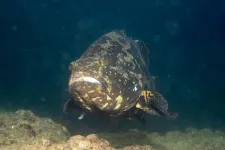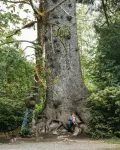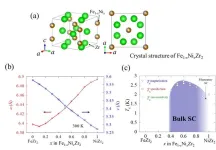(Press-News.org) A new review on zoonotic infections — diseases transmitted by animals — in the Canadian Arctic provides timely guidance to clinicians as the region experiences heightened global interest as well as climate change, which threatens the region and increases risk of disease transmission. The review, published in CMAJ (Canadian Medical Association Journal) https://www.cmaj.ca/lookup/doi/10.1503/cmaj.240541, provides guidance on how to identify and manage seven zoonotic infections in people.
“Indigenous Peoples continue to be caretakers of the Canadian Arctic; their cultural connection with the Arctic environment and ecosystem generates unique exposures to the zoonotic diseases discussed, as well as others not covered here,” writes Dr. Justin Penner, an infectious diseases physician at CHEO, Ottawa, Ontario, and Qikiqtani General Hospital, Iqaluit, Nunavut, with coauthors.
The Canadian Arctic includes three different bioclimates — subarctic, low arctic, and high arctic — over a vast geographic area with Inuit, Gwich’in and Athabaskan peoples representing the region’s Indigenous communities.
The authors urge clinicians with patients from the Arctic to apply a holistic perspective, respecting Inuit Qaujimajatuqangit, a term that describes Inuit Traditional Knowledge, combined with the One Health principle. One Health asserts that diseases in humans are influenced by the interaction between humans, nature, and the animal world.
“Cultural proximity and interaction with the Arctic ecosystem are important factors in understanding some of the under-recognized infectious diseases within the region. Clinicians’ respect and understanding of these customs can highlight infectious exposures, guide clinical care, and inform prevention programs,” the authors write.
Risk factors for Arctic zoonotic infections include diets of “country foods” — wild game, fish and sea mammals — that are consumed as part of a traditional healthy diet in many Arctic communities. Hunting, harvesting animals, and preparing animal skins as well as owning sled dogs are also risk factors for diseases acquired from animals.
Climate change in the Arctic is affecting the local ecosystem.
“Animal behaviour is changing, including migration patterns, largely as a result of diminishing sea ice, which limits hunting. These factors can affect parasite life cycles. Melting permafrost has an impact on how food is processed, making practices like fermentation and ice-cellar storage less reliable. Warmer temperatures also promote the spread of insect vectors into higher latitudes, which will further affect Arctic ecosystems and cause emergence of other infections in the region where populations are vulnerable,” the authors write.
The article includes several illustrations showing the interrelatedness of people and animals and disease transmission.
END
Guidance on animal-borne infections in the Canadian Arctic
2025-01-20
ELSE PRESS RELEASES FROM THIS DATE:
Fatty muscles raise the risk of serious heart disease regardless of overall body weight
2025-01-20
People with pockets of fat hidden inside their muscles are at a higher risk of dying or being hospitalised from a heart attack or heart failure, regardless of their body mass index, according to research published in the European Heart Journal [1] today (Monday).
This ‘intermuscular’ fat is highly prized in beef steaks for cooking. However, little is known about this type of body fat in humans, and its impact on health. This is the first study to comprehensively investigate the effects of fatty muscles on heart disease.
The new finding adds evidence that existing measures, such as body mass index or waist ...
HKU ecologists uncover significant ecological impact of hybrid grouper release through religious practices
2025-01-19
Ecologists from the School of Biological Sciences (SBS) and the Swire Institute of Marine Science (SWIMS) at The University of Hong Kong (HKU) have identified significant ecological risks associated with the release of hybrid groupers into Hong Kong’s coastal waters, a practice often linked to religious ‘mercy release’ rituals.
Their study highlights how the Tiger Grouper-Giant Grouper hybrid (TGGG), also known as the Sabah grouper, disrupts local marine ecosystems by exploiting unique ecological niches and potentially becoming a dominant predator. This research, the first ...
New register opens to crown Champion Trees across the U.S.
2025-01-18
The National Champion Tree Program (NCTP) announced its first Register of Champion Trees since 2021. The program moved from American Forests to the University of Tennessee School of Natural Resources in 2023 and has spent the past year working with state-level Champion Tree programs across the U.S. to update outdated records and verify the newly crowned champions.
“We are thrilled beyond measure to share the list of the largest documented trees in the United States,” Jaq Payne, NCTP director, said. “These trees are more than just numbers on a website. They're living, breathing members of our community. I hope this register encourages folks to start ...
A unified approach to health data exchange
2025-01-18
About The Article: This article outlines the ways in which the U.S. Department of Health and Human Services has worked to use electronic health record data to improve patient health, public health, and health care.
Corresponding Author: To contact the corresponding author, Robert M. Califf, MD, email commissioner@fda.hhs.gov.
To access the embargoed study: Visit our For The Media website at this link https://media.jamanetwork.com/
(doi:10.1001/jama.2025.0068)
Editor’s ...
New superconductor with hallmark of unconventional superconductivity discovered
2025-01-18
Tokyo, Japan – Researchers from Tokyo Metropolitan University have discovered a new superconducting material. They combined iron, nickel, and zirconium, to create a new transition metal zirconide with different ratios of iron to nickel. While both iron zirconide and nickel zirconide are not superconducting, the newly prepared mixtures are, exhibiting a “dome-shaped” phase diagram typical of so-called “unconventional superconductors,” a promising avenue for developing high temperature superconducting materials which can be more widely deployed in society.
Superconductors already play ...
Global HIV study finds that cardiovascular risk models underestimate for key populations
2025-01-18
Cardiovascular disease (CVD) is the leading cause of morbidity and mortality globally, posing a particularly significant threat to people with HIV (PWH). To address this, CVD prevention plans rely on prediction models like atherosclerotic cardiovascular disease (ASCVD) risk scores to estimate the risk of heart disease.
However, previous studies have called into question whether these commonly used prediction models perform well among people with HIV, and there remains a gap in understanding of what these scores mean for PWH in low- and middle-income countries (LMICs).
Researchers from Massachusetts General Hospital, a founding member of the Mass General Brigham ...
New study offers insights into how populations conform or go against the crowd
2025-01-17
Cultural traits — the information, beliefs, behaviors, customs, and practices that shape the character of a population — are influenced by conformity, the tendency to align with others, or anti-conformity, the choice to deliberately diverge. A new way to model this dynamic interplay could ultimately help explain societal phenomena like political polarization, cultural trends, and the spread of misinformation.
A study published in the Proceedings of the National Academy of Sciences outlines this novel approach. Presenting a mathematical model, SFI Complexity Postdoctoral Fellow Kaleda Denton with colleagues ...
Development of a high-performance AI device utilizing ion-controlled spin wave interference in magnetic materials
2025-01-17
A research team from NIMS and the Japan Fine Ceramics Center (JFCC) has developed a next-generation AI device—a hardware component for AI systems—that incorporates an iono-magnonic reservoir. This reservoir controls spin waves (collective excitations of electron spins in magnetic materials), ion dynamics and their interactions. The technology demonstrated significantly higher information processing performance than conventional physical reservoir computing devices, underscoring its potential to transform AI technologies.
As AI devices become increasingly sophisticated, ...
WashU researchers map individual brain dynamics
2025-01-17
By Shawn Ballard
The complexity of the human brain – 86 billion neurons strong with more than 100 trillion connections – enables abstract thinking, language acquisition, advanced reasoning and problem-solving, and the capacity for creativity and social interaction. Understanding how differences in brain signaling and dynamics produce unique cognition and behavior in individuals has long been a goal of neuroscience research, yet many phenomena remain unexplained.
A study from neuroscientists and ...
Technology for oxidizing atmospheric methane won’t help the climate
2025-01-17
As the atmosphere continues to fill with greenhouse gases from human activities, many proposals have surfaced to “geoengineer” climate-saving solutions, that is, alter the atmosphere at a global scale to either reduce the concentrations of carbon or mute its warming effect.
One recent proposal seeks to infuse the atmosphere with hydrogen peroxide, insisting that it would both oxidize methane (CH4), an extremely potent greenhouse gas while improving air quality.
Too good to be true?
University of Utah atmospheric scientists Alfred Mayhew and Jessica Haskins were skeptical, so they set out to test the claims behind this proposal. Their results, published on ...





